Papers by FrÜhling Rijsdijk

Objective. Countless associations between risk factors and outcomes are reported in epidemiologic... more Objective. Countless associations between risk factors and outcomes are reported in epidemiological research, but often without estimating the contribution from genetics. However most outcomes and risk factors are substantially heritable, and genetic influences can confound these associations. Here we propose a two-stage approach for evaluating the role of shared genetic effects in explaining these observed associations. Method. Genotyped unrelated participants from the Twins Early Development Study are included (N from 3,663 to 4,693 depending on the outcome) in our analyses. As an example for our proposed approach, we focus on maternal educational attainment, a risk factor known to associate with a variety of offspring social and health outcomes, including child educational achievement, Body Mass Index, and Attention Deficit Hyperactivity Disorders (ADHD). In the first stage of our approach we estimate how much of the phenotypic associations between maternal education and child outcomes can be attributed to shared genetic effects via regressions controlling for increasingly powerful polygenic scores. In the second stage, we estimate shared genetic effects using heritability estimates and genetic correlations equal to those derived in both SNP-based and twin-based studies. Finally, evidence from the two stages are evaluated in conjunction to provide an overall assessment of the likelihood that the association is explained by genetics. Results. Associations between maternal education and the three developmental outcomes are highly significant. The magnitude of these associations decrease when using polygenic scores to account for shared genetic effects, explaining between 14.3% and 24.3% of the original associations. For the three outcomes, the magnitude of these associations further decrease under a SNP-based heritability scenario and are almost entirely or entirely explained by genetics under a twin-based heritability scenario. Conclusions. Observed association between maternal education and child educational attainment, BMI and ADHD symptoms may be largely explained by genetics. To the extent that available estimates of SNP-based and twin-based heritabilities are accurate, the present findings represent a call for caution .
Nature Reviews Genetics, 2018
Causal inference, which involves progressing from confounded statistical associations to evidence... more Causal inference, which involves progressing from confounded statistical associations to evidence of causal relationships, is essential across the biomedical, behavioural and social sciences; it can reveal complex pathways underlying diseases and traits and help to prioritize targets for interventions. Recent progress in genetic epidemiologyincluding statistical innovation, massive genotyped datasets and novel computational tools for deep data mininghas fostered the intense development of methods exploiting genetic data and relatedness to strengthen causal inference in observational research. In this Review, we describe how such genetically informed methods differ in their rationale, applicability and inherent limitations, and outline how they should be integrated in future to offer a rich causal inference toolbox.
Child development, Jan 25, 2017
Emotional overeating (EOE) is the tendency to eat more in response to negative emotions; its etio... more Emotional overeating (EOE) is the tendency to eat more in response to negative emotions; its etiology in early life is unknown. We established the relative genetic and environmental influences on EOE in toddlerhood and early childhood. Data were from Gemini, a population-based cohort of 2,402 British twins born in 2007. EOE was measured using the "emotional overeating" scale of the Child Eating Behavior Questionnaire (CEBQ) at 16 months and 5 years. A longitudinal quantitative genetic model established that genetic influences on EOE were minimal; on the other hand, shared environmental influences explained most of the variance. EOE was moderately stable from 16 months to 5 years and continuing environmental factors shared by twin pairs at both ages explained the longitudinal association.
Psychoneuroendocrinology, 2008
Take-down policy If you believe that this document breaches copyright please contact us providing... more Take-down policy If you believe that this document breaches copyright please contact us providing details, and we will remove access to the work immediately and investigate your claim.

Journal of Affective Disorders, 2010
Background: The purpose of this review is to systematically appraise the peer-reviewed literature... more Background: The purpose of this review is to systematically appraise the peer-reviewed literature about the genetic and environmental determinants of psychiatric comorbidity, focusing on four of the most prevalent types of psychopathology: anxiety disorders, depression, conduct disorder and substance abuse. Methods: We summarize existing empirical research on the relative contribution that genetic, nonshared and shared environmental factors make to the covariance between disorders, and evidence about specific genes and environmental characteristics that are associated with comorbidity. Results: Ninety-four articles met the inclusion criteria and were assessed. Genetic factors play a particularly strong role in comorbidity between major depression and generalized anxiety disorder or posttraumatic stress disorder, while the non-shared environments make an important contribution to comorbidity in affective disorders. Genetic and non-shared environmental factors also make a moderate-to-strong contribution to the relationship between CD and SA. A range of candidate genes, such as 5HTTLPR, MAOA, and DRD1-DRD4, as well as others implicated in the central nervous system, has been implicated in psychiatric comorbidity. Pivotal social factors include childhood adversity/life events, family and peer social connections, and socioeconomic and academic difficulties. Limitations: Methodological concerns include the use of clinical case-control samples, the focus on a restricted set of individual-level environmental risk factors, and restricted follow-up times. Conclusions: Given the significant mental health burden associated with comorbid disorders, population-based research on modifiable risk factors for psychiatric comorbidity is vital for the design of effective preventive and clinical interventions.
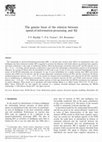
Behavioural Brain Research, 1998
The relationship of speed-of-information-processing (SIP), as derived from reaction times (RTs) o... more The relationship of speed-of-information-processing (SIP), as derived from reaction times (RTs) on experimental tasks, and intelligence has been extensively studied. SIP is suggested to measure the efficiency with which subjects can perform basic cognitive operations underlying a wide range of intellectual abilities. Observed phenotypic correlations between RT and IQ typically are in the −0.2 to −0.4 range, and the question is addressed to what extent this relationship is determined by genetic or environmental influences. In a group of Dutch twins the heritabilities for RT tasks at age 16 and 18 years were estimated longitudinally and the nature of the RT-IQ relationship was investigated. At age 16 years heritabilities for a simple reaction time (SRT) and choice reaction time (CRT) were 64 and 62% and the average phenotypic correlations between the RTs and IQ, assessed by the Raven standard progressive matrices, was − 0.21. At the second test occasion lower heritabilities were observed for the RTs, probably due to modifications in administration procedures. The mean correlations between the RTs and WAIS verbal and per formal subtests were − 0.18 and − 0.16. Multivariate genetic analyses at both ages showed that the RT-IQ correlations were explained by genetic influences. These results are in agreement with earlier findings (
Journal of Affective Disorders, 2021
Highlights • Obsessive-compulsive symptoms (OCS) are associated with risk of suicidality in youth... more Highlights • Obsessive-compulsive symptoms (OCS) are associated with risk of suicidality in youth.• Taboo obsessions are more robustly linked with suicidality than other OCS.• OCS in late adolescence prospectively predict suicidality in early adulthood.• Genetic factors explain much of the relationship between OCS and suicidality.• Non-shared environmental factors also contribute to the relationship.
Supplemental material, Supplement_JAD for The Etiological Structure of Cognitive-Neurophysiologic... more Supplemental material, Supplement_JAD for The Etiological Structure of Cognitive-Neurophysiological Impairments in ADHD in Adolescence and Young Adulthood by Giorgia Michelini, Celeste H. M. Cheung, Viryanaga Kitsune, Daniel Brandeis, Tobias Banaschewski, Gráinne McLoughlin, Philip Asherson, Frühling Rijsdijk and Jonna Kuntsi in Journal of Attention Disorders
Shared genetic influences on ADHD symptoms and very low-frequency EEG activity: A twin study
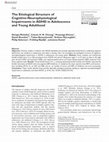
Journal of Attention Disorders, 2018
Objective: Previous studies in children with ADHD identified two partially separable familial fac... more Objective: Previous studies in children with ADHD identified two partially separable familial factors underlying cognitive dysfunction, but evidence in adolescents and adults is lacking. Here, we investigate the etiological structure of cognitive-neurophysiological impairments in ADHD in adolescents and young adults. Method: Factor analyses and multivariate familial models were run in 356 participants from ADHD and control sibling pairs aged 11 to 27 years on data on IQ, digit span forward (DSF) and backward (DSB), and cognitive-performance and event-related potential (ERP) measures from three cognitive tasks. Results: Three familial factors (cF1-3), showing substantial familial overlap with ADHD, captured the familial covariation of ADHD with nine cognitive-ERP measures. cF1 loaded on IQ, mean reaction time (MRT), and reaction-time variability (RTV); cF2 on DSF and DSB; and cF3 on number of errors and ERPs of inhibition and error processing. Conclusion: These results identify three...

Sleep, 2010
Study Objectives: To examine the extent to which genetic and environmental factors influence comp... more Study Objectives: To examine the extent to which genetic and environmental factors influence components of sleep quality; the degree to which these components co-occur; and genetic and environmental influences on this co-occurrence. Design: Twin study. Setting: Population based twin registry across the UK. Patients or Participants: Four hundred twenty monozygotic twins, 773 dizygotic twins, and 363 siblings (mode age = 20 years; range 18 to 27 years). Interventions: N/A Measurements and Results: The Pittsburgh Sleep Quality Index (PSQI) assessed 7 components of sleep quality which overlap to varying degrees. Genetic influence on individual components ranged from 0% to 47%. The remaining source of variance was non-shared environment, except for "sleep duration," for which shared environmental influences were important. Phenotypic correlations between components ranged from 0.22 to 0.61. Bivariate analyses indicated substantial overlap between genes influencing phenotypes (10 of 15 correlations were ≥ 0.69); and in general, genetic influence accounted for roughly half the association (> 40% in 9 of 15 correlations). Non-shared environmental influences were in general less correlated across variables (11 of 15 were < 0.4), but owing to their greater influence on each variable, still accounted for roughly half of each association (≥ 40% in 12 of 15 correlations). Conclusions: Genetic and non-shared environmental factors are most important in explaining individual differences with regards to different components of sleep quality, although shared environment may influence sleep duration. The pattern of overlap in the genetic and environmental influences accounting for the associations between components of sleep quality is consistent with that seen in other areas of developmental psychopathology of general genes and specific non-shared environmental influences.

Journal of the American Academy of Child and Adolescent Psychiatry, 2017
Advanced paternal age (APA) at conception has been linked with autism and schizophrenia in offspr... more Advanced paternal age (APA) at conception has been linked with autism and schizophrenia in offspring, neurodevelopmental disorders that affect social functioning. The current study explored the effects of paternal age on social development in the general population. We used multilevel growth modeling to investigate APA effects on socioemotional development from early childhood until adolescence, as measured by the Strengths and Difficulties Questionnaire (SDQ) in the Twins Early Development Study (TEDS) sample. We also investigated genetic and environmental underpinnings of the paternal age effects on development, using the Additive genetics, Common environment, unique Environment (ACE) and gene-environment (GxE) models. In the general population, both very young and advanced paternal ages were associated with altered trajectory of social development (intercept: p = .01; slope: p = .03). No other behavioral domain was affected by either young or advanced age at fatherhood, suggestin...

Journal of child psychology and psychiatry, and allied disciplines, Jan 27, 2015
The etiology of Autism Spectrum Disorder (ASD) has been recently debated due to emerging findings... more The etiology of Autism Spectrum Disorder (ASD) has been recently debated due to emerging findings on the importance of shared environmental influences. However, two recent twin studies do not support this and instead re-affirm strong genetic effects on the liability to ASD, a finding consistent with previous reports. This study conducts a systematic review and meta-analysis of all twin studies of ASD published to date and explores the etiology along the continuum of a quantitative measure of ASD. A PubMed Central, Science Direct, Google Scholar, Web of Knowledge structured search conducted online, to identify all twin studies on ASD published to date. Thirteen primary twin studies were identified, seven were included in the meta-analysis by meeting Systematic Recruitment criterion; correction for selection and ascertainment strategies, and applied prevalences were assessed for these studies. In addition, a quantile DF extremes analysis was carried out on Childhood Autism Spectrum Te...
Journal of the American Academy of Child & Adolescent Psychiatry, 2016
If citing, it is advised that you check and use the publisher's definitive version for pagination... more If citing, it is advised that you check and use the publisher's definitive version for pagination, volume/issue, and date of publication details. And where the final published version is provided on the Research Portal, if citing you are again advised to check the publisher's website for any subsequent corrections.

The Journal of neuroscience : the official journal of the Society for Neuroscience, Jan 16, 2015
Acquisition of language skills depends on the progressive maturation of specialized brain network... more Acquisition of language skills depends on the progressive maturation of specialized brain networks that are usually lateralized in adult population. However, how genetic and environmental factors relate to the age-related differences in lateralization of these language pathways is still not known. We recruited 101 healthy right-handed subjects aged 9-40 years to investigate age-related differences in the anatomy of perisylvian language pathways and 86 adult twins (52 monozygotic and 34 dizygotic) to understand how heritability factors influence language anatomy. Diffusion tractography was used to dissect and extract indirect volume measures from the three segments of the arcuate fasciculus connecting Wernicke's to Broca's region (i.e., long segment), Broca's to Geschwind's region (i.e., anterior segment), and Wernicke's to Geschwind's region (i.e., posterior segment). We found that the long and anterior arcuate segments are lateralized before adolescence and ...

Background: Elevated levels of sensory abnormalities, such as hypo- and hyper-sensitivity to soun... more Background: Elevated levels of sensory abnormalities, such as hypo- and hyper-sensitivity to sound, light, touch, and taste, are well-documented in autism (e.g. Leekam et al., 2007, Rogers & Ozonoff, 2005) as well as in Fragile X (Rogers et al., 2003). Since autism and Fragile X are both highly heritable, genetic factors may also be involved in sensory abnormalities. Studies so far indicate moderate heritability of sensory sensitivity in typically developing samples (e.g. Goldsmith et al., 1997), with some indication that the tactile domain might be more heritable than the auditory domain (Goldsmith et al. 2006). A sibling study of sensory abnormalities in ASD (Szatmari et al., 2006) examined the structure of the restricted, repetitive behaviours and interests domain in autism measured by the ADI. Using factor analysis, they found that this domain consists of 2 factors: 'insistence on sameness' (IS) and 'repetitive and sensory motor behaviours and interests' (RSMB). ...
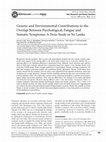
Twin Research and Human Genetics, 2011
Background:Somatic symptoms often co-occur with psychological symptoms but this overlap is poorly... more Background:Somatic symptoms often co-occur with psychological symptoms but this overlap is poorly understood. Some aspects of this overlap differ in the South Asian context, but it is not clear whether this is a reporting effect or an underlying difference in experienced illness.Methods:Home interviews were administered to 4,024 twins randomly selected from a population-based twin register in the Colombo district of Sri Lanka (the CoTASS study). These included assessments of psychological, somatic and fatigue symptoms. The data were analyzed using factor analytic and quantitative genetic approaches.Results:Confirmatory factor analysis showed that the symptoms from the three scales represented three separate dimensions, rather than all tapping into a single dimension. However, familial correlations among the data were most consistent with a common pathway model. This implies that a portion of the underlying vulnerability is common across psychological, fatigue and somatic symptoms. T...
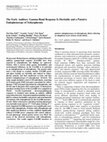
Schizophrenia Bulletin, 2009
Background: Reduced power and phase locking of the early auditory gamma-band response (EAGBR) hav... more Background: Reduced power and phase locking of the early auditory gamma-band response (EAGBR) have been reported in schizophrenia, but findings are equivocal. Further, little is known about genetic (heritability) and environmental influences on the EAGBR or its potential as an endophenotype of schizophrenia. The present study used a twin design to examine whether EAGBR power and phase locking are heritable and reduced in schizophrenic patients and their unaffected co-twins and thus putative endophenotypes of schizophrenia. Methods: The study sample included a total of 194 individuals, consisting of 15 monozygotic [MZ] twin pairs concordant for schizophrenia, 9 MZ twin pairs discordant for schizophrenia, and 42 MZ and 31 dizygotic (DZ) control pairs. Evoked power and phase-locking factor of the EAGBR were computed on Morlet wavelet-transformed electroencephalogram responses to standard tones during an auditory oddball target detection task. Structural equation modeling was applied to estimate heritability and genetic and environmental correlations with schizophrenia for the EAGBR measures. Results: Both evoked power and phase-locking phenotypes were heritable traits (power: h 2 5 0.65; phase locking: h 2 5 0.63). Impaired EAGBR measures were significantly associated with schizophrenia. Patients with schizophrenia and their unaffected identical co-twins exhibited significantly reduced EAGBR power compared with control subjects. In each phenotype, shared genetic factors were likely the source of the observed associations with schizophrenia. Conclusions: Our results support EAGBR measures as putative endophenotypes of schizophrenia, likely reflecting an ubiquitous local cortical circuit deficit.
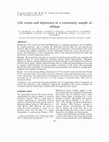
Psychological Medicine, 2001
Background. The overall aim of the GENESiS project is to identify quantitative trait loci (QTLs) ... more Background. The overall aim of the GENESiS project is to identify quantitative trait loci (QTLs) for anxiety/depression, and to examine the interaction between these loci and psychosocial adversity. Here we present life-events data with the aim of clarifying: (i) the aetiology of life events as inferred from sibling correlations; (ii) the relationship between life events and measures of anxiety and depression, as well as neuroticism; and (iii) the interaction between life events and neuroticism on anxiety/depression indices.Methods. We assessed the occurrence of one network and three personal life-event categories and multiple indices of anxiety/depression including General Health Questionnaire, Anhedonic Depression, Anxious Arousal and Neuroticism in a large community-based sample of 2150 sib pairs, 410 trios and 81 quads. Liability threshold models and raw ordinal maximum likelihood were used to estimate within-individual and between-sibling correlations of life events. The relati...
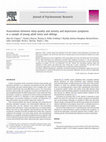
Journal of Psychosomatic Research, 2011
Objectives: Little is known about the aetiology of the links between sleep disturbance and anxiet... more Objectives: Little is known about the aetiology of the links between sleep disturbance and anxiety and depression symptoms. The aim of this study was to estimate genetic and environmental influences on these associations. Methods: Questionnaires were completed by 1556 young adults from twin and sibling pairs (61.5% female). Results: Sleep disturbance was moderately correlated with symptoms of anxiety (r=.39) and depression (r=.50). There was substantial overlap between genes influencing sleep disturbance and those influencing symptoms of anxiety (rA=.58) and depression (rA=.68). Overall, the associations between sleep and symptoms of both anxiety and depression were mainly due to genes (explaining 74% and 58% of the covariances respectively), with the remainder due to nonshared environmental factors. Conclusions: Moderate phenotypic and genetic correlations between the phenotypes support the view that sleep disturbance is related to the presence of various psychiatric difficulties, but also warrants independent consideration and treatment.

Uploads
Papers by FrÜhling Rijsdijk